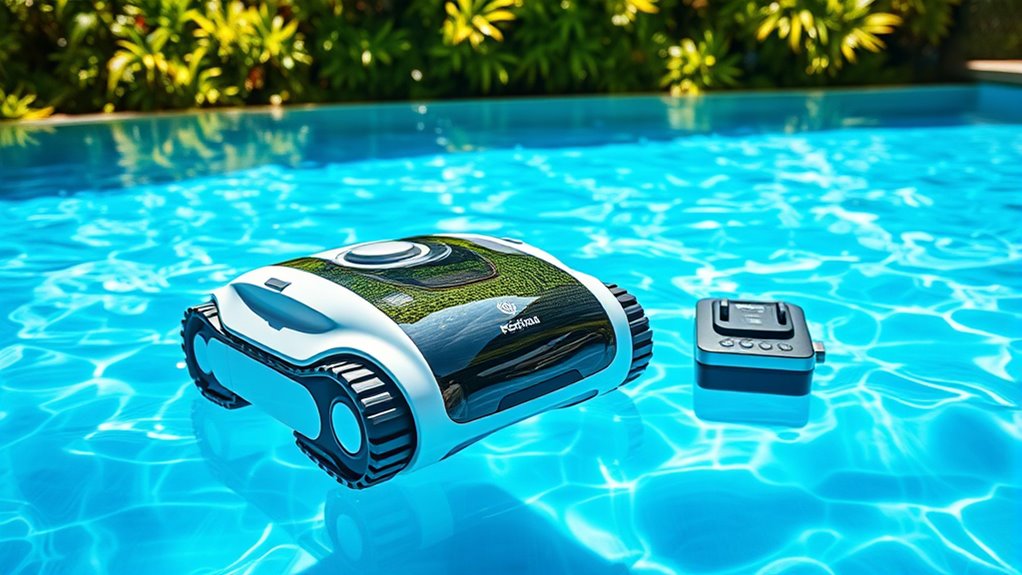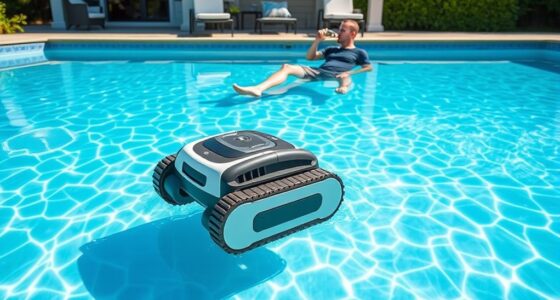When choosing a robotic pool cleaner, consider its battery life to ensure it can cover your pool fully without constant charging, and look for models with multiple cleaning modes like spot, floor, or wall cleaning for versatility. Check how well the navigation features map your pool to avoid missed spots, and choose one that’s easy to maintain with simple access to filters and brushes. Finally, guarantee it’s durable and compatible with your pool size. Keep these points in mind to find the right fit.
Key Takeaways
- Battery life and runtime to ensure full pool coverage without frequent recharging.
- Cleaning modes and automation features for customized and efficient cleaning.
- Ease of operation, including controls, scheduling, and maintenance requirements.
- Compatibility with pool size, shape, and materials for thorough cleaning and durability.
- Navigation and mapping capabilities to maximize coverage and prevent missed spots.

A robotic pool cleaner can make maintaining your pool much easier, but to get the best results, you need to use it correctly. One of the key factors to consider is battery life. A cleaner with a longer-lasting battery allows you to cover the entire pool without interruptions, especially if you have a large or deep pool. Check the estimated runtime on a single charge—ideally, it should be sufficient to clean your entire pool in one go. Keep in mind that battery performance can degrade over time, so look for models with good reviews on battery durability or options for easy replacement. A device with a short battery life might require multiple charging cycles, which can be inconvenient and extend cleaning times.
Another important aspect is cleaning modes. Many robotic cleaners come with multiple modes designed for different cleaning needs, such as spot cleaning, floor cleaning, or wall climbing. Opt for a model that offers adaptable cleaning modes, so you can customize the cleaning process based on your pool’s condition. For example, if your pool tends to accumulate leaves and debris along the walls and floor, having a cleaner with targeted modes can save you time and effort. Some models automatically switch between modes, while others require manual adjustments. Understanding what modes are available and how to activate them ensures you’re getting the most efficient clean possible. Additionally, performance features like advanced navigation algorithms can significantly improve coverage and efficiency, saving you time and energy. Furthermore, automated mapping capabilities can help the cleaner optimize its route and avoid redundant cleaning passes. When choosing a model, also consider the availability of replacement parts to ensure easy maintenance and longevity of the device.
In addition to battery life and cleaning modes, consider the ease of use. Look for models that are simple to program and operate, preferably with remote controls or smartphone apps. This makes it easier to schedule cleanings and monitor progress without hassle. Also, examine the cleaner’s navigation system—models with advanced mapping algorithms can map your pool more effectively, avoiding missed spots or repeated passes. Proper maintenance routines such as regular filter cleaning can help prolong the lifespan of your device and ensure optimal performance.
Durability and maintenance are also crucial. A robust build with resistant materials will stand up to regular use and pool chemicals. Check how easy it is to clean or replace filters and brushes, since regular maintenance keeps your cleaner performing at its best. Finally, think about the size and shape of your pool; some models are better suited for specific pool types, so match your choice to your pool’s dimensions for maximum coverage.
Frequently Asked Questions
How Energy-Efficient Are Robotic Pool Cleaners?
Robotic pool cleaners are generally quite energy-efficient, helping you save on power consumption while keeping your pool pristine. They use advanced technology to optimize power efficiency, meaning they don’t draw excessive energy during operation. You’ll notice lower electricity bills and a greener footprint, as many models are designed to operate with minimal energy use. Overall, these cleaners balance effective cleaning with energy efficiency, making them a smart choice for eco-conscious pool owners.
Can Robotic Pool Cleaners Handle Large Debris?
Robotic pool cleaners are like diligent workers, but their ability to handle large debris depends on their debris capacity and clog management. If you choose a model with a higher debris capacity, it can scoop up leaves and larger debris without frequent emptying. Good clog management features ensure the cleaner keeps running smoothly, preventing jams. So, opt for a model with these features, and it’ll tackle big debris with ease.
What Is the Typical Lifespan of a Robotic Pool Cleaner?
A robotic pool cleaner typically lasts 3 to 8 years, depending on usage and maintenance. You should check the warranty coverage, which often covers 1 to 2 years, and guarantee replacement parts are readily available. Proper care, like regular cleaning and avoiding obstacles, extends its lifespan. Investing in a model with good warranty coverage and easy access to replacement parts helps ensure you get the most out of your cleaner.
Are Robotic Pool Cleaners Suitable for All Pool Types?
They say “if the shoe fits, wear it,” and the same applies to robotic pool cleaners. Whether they’re suitable depends on your pool size and surface material. For large pools, look for models with strong suction and extended cords. For surfaces like tile or vinyl, choose cleaners designed for those materials. Most robotic cleaners work well on various types, but always check compatibility to guarantee effective cleaning.
How Often Should I Maintain and Service My Robotic Cleaner?
You should follow a regular maintenance schedule for your robotic pool cleaner to keep it running smoothly. Typically, you’ll want to check and clean the filter after each use and perform more thorough service intervals every few months. Regularly inspect the brushes and cables, replacing parts as needed. Proper maintenance guarantees peak cleaning performance, prolongs the lifespan of your robot, and prevents unexpected breakdowns.
Conclusion
Ultimately, choosing the right robotic pool cleaner depends on understanding your needs and doing a bit of research. Many believe these devices save time and effort, but some wonder if they truly deliver on their promises. The truth is, with the right model and proper maintenance, a robotic cleaner can be a game changer for your pool routine. Trust your instincts, consider expert opinions, and enjoy sparkling clean water without the hassle.









